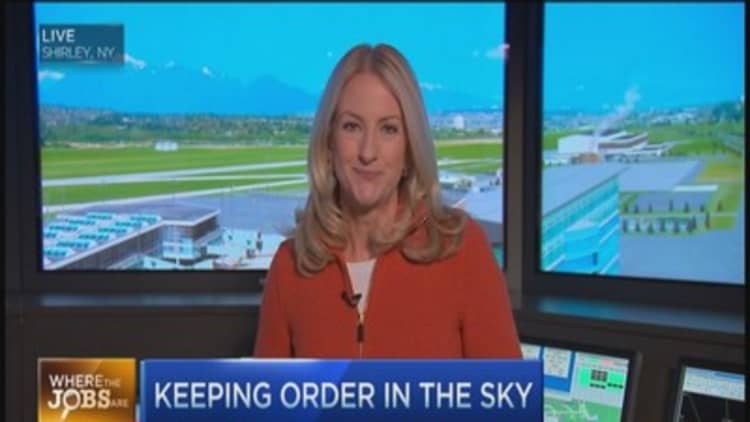
Saja-Lindsay Sudlow has known for years she wanted a job in aviation, ever since her high school job manning the museum booth in the Old Rhinebeck Aerodrome in Red Hook in New York City.
"This is something I always wanted to do," the 23-year-old said.
A recent graduate of Dowling College in Shirley, New York, Sudlow's dream is about to take flight. She was recently accepted into the FAA's Air Traffic Controller Training program at the FAA Academy in Oklahoma City. She is currently waiting for word on when she can begin her studies.
"The great thing about it is you can get a job anywhere on the continental United States," she said. "And you can go places."
The FAA will need plenty of candidates like Sudlow over the next decade to man its 315 towers. The agency's hiring plan calls for it to bring on 10,000 new controllers in the next 10 years, including 1,724 in 2015.
"They have to be hired by their 31st birthday. They have to retire by the age of 56," said Gail Zlotky, air traffic control program manager at Middle Tennessee State University. "That's why the job market will keep going."
This job market right now is particularly hot.The FAA is catching up on hiring postponed by budget cuts imposed by last year's sequestration, and thousands of the 14,100 air traffic controllers on the job now are nearing that mandatory retirement age.
Read MorePrescription for job growth: Medical coders in demand
"If you figured 11,000 controllers were hired between 1981 and 1991, there's going to be a large number of controllers leaving by their 56th birthday," said Joe Denofrio, assistant professor at Dowling's aviation program, speaking of the controllers hired after President Ronald Reagan fired thousands during a strike in 1981.
Until this year, the FAA drew a majority of its candidates from two sources: the military and a group of 36 colleges, including Dowling and Middle Tennessee State, which were part of the FAA's collegiate training initiative. Top graduates from these schools were typically assured a spot in the FAA's ATC training program, but now they have to apply along with the rest of the general public who meet certain qualifications. The qualifications include being a U.S. citizen, four years of course study toward a bachelor's degree or at least three years of work experience.
If a candidate meets these and other criteria, they then have to pass a test introduced this year, a biographical assessment.
The schools that used to serve as feeder programs to the FAA are somewhat flummoxed as to why the changes were made. They declined to comment for this article on what they think were behind those changes. Their concern lies in the fact some said their better students failed the biographical test and there is no way for them to know why they failed, and how they might study to make sure they pass the next time.
The FAA did not answer repeated calls and emails from CNBC as to why it changed its admissions process, why the test was introduced, and if it has been successful in bringing in a larger pool of qualified candidates.
"The FAA sets its own hiring policies and NATCA is not involved in those decisions," said the National Air Traffic Control Association in a statement emailed to CNBC. NATCA said it is working closely with the FAA to refine the assessment for the next open job announcement.
Read MoreMaritime boom: More hands needed on deck
In the meantime, Middle Tennessee State and Dowling continue to teach students interested in air traffic control. The students take courses in the theory of flight, laws and regulation and basic aerodynamics as well as others. In addition, the students spend weeks in simulators and towers learning from seasoned controllers.
"We have three retired air traffic controllers that actually teach the labs, so they (the students) can get real world experience," Zlotky said.
In the real world, these future controllers will help manage the more than 87,000 flights that take off and land here in the U.S. each day, but only after they graduate from the FAA's program and spend a few years getting supervised on-the-job training. Once they are certified and depending on where they work, some will earn more than $100,000 a year.
It wasn't the money but the love of speed that brought Deangelo Blair to choose a career in aviation. Originally he wanted to fly jets but was put off by the price of flying lessons. He is now focused on getting into the FAA ATC program once he receives his degree from Middle Tennessee State, even though he knows he may not be accepted.
Read MoreThis firm helps others by growing its own workforce
"If anything I'm going to keep my passion about air traffic control," he said, adding he would hope to find another job in aviation, if he is not accepted by the FAA.
That kind of passion is what Denofrio said brings so many students to Dowling. Beyond that, he said what will make them good air traffic controllers is "focus, situational awareness and multitasking."
In this line of work, you need to keep yourself grounded, while keeping your eyes on the sky.
ReadMore

